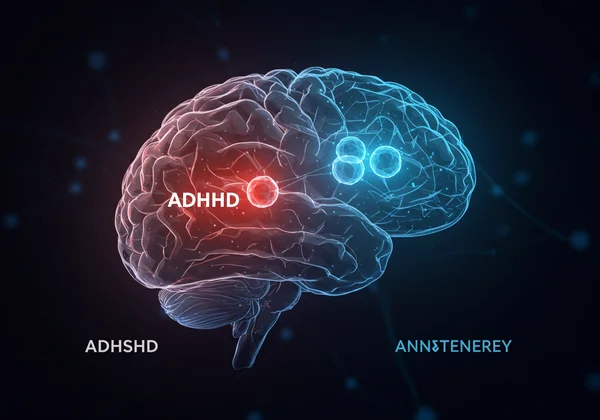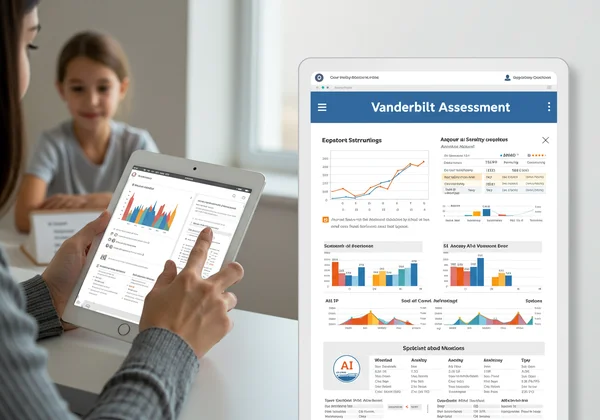ADHD & Childhood Anxiety: How Vanderbilt Assessment Helps
As parents and educators, watching a child struggle can be a deeply confusing and challenging experience. You might notice they have trouble focusing in class, yet also seem paralyzed by worry. Perhaps their boundless energy looks like hyperactivity, but it could also be nervous restlessness. This overlap between ADHD and anxiety symptoms is incredibly common in children aged 6-12, making it difficult to understand what’s truly going on. This is why a comprehensive Vanderbilt Assessment is such a valuable first step. What conditions does the Vanderbilt Assessment screen for? It’s designed not just to identify potential ADHD, but also to flag co-occurring issues like anxiety, providing the clarity needed to seek the right support.

For families and teachers seeking answers, the journey often begins with uncertainty. The good news is that structured, evidence-based tools can light the way. The NICHQ Vanderbilt Assessment Scale is a trusted instrument used by professionals to gather detailed behavioral insights. By using a convenient online vanderbilt assessment, you can transform your observations into structured data, creating a clear starting point for a productive conversation with a healthcare provider.
Understanding ADHD & Anxiety in Children: The Overlap
It is crucial to recognize that ADHD and anxiety are not mutually exclusive; in fact, they frequently coexist. Research indicates that a significant percentage of children with ADHD also have a co-occurring anxiety disorder. Untangling these intertwined conditions is the first step toward effective support, as the strategies that help with one might not be sufficient for the other. This makes a comprehensive ADHD screening tool essential for a holistic view.
Recognizing Common Symptoms in 6-12 Year Olds
At first glance, the symptoms of ADHD and anxiety can appear strikingly similar, leading to confusion. A child’s behavior is complex, and understanding the nuances is key to providing the right kind of help.
Typical ADHD Symptoms:
- Inattention: Difficulty sustaining focus, seems to not listen, is easily distracted, loses things frequently, and struggles with organization.
- Hyperactivity: Fidgets or squirms constantly, leaves their seat when expected to remain seated, runs or climbs excessively.
- Impulsivity: Blurts out answers, has trouble waiting their turn, interrupts others’ conversations or games.
Typical Childhood Anxiety Symptoms:
- Excessive Worry: Constant, uncontrollable worry about school, friendships, health, or future events.
- Restlessness & Irritability: Appears on edge, fidgety, or easily annoyed—this can be mistaken for hyperactivity.
- Physical Complaints: Frequent headaches, stomachaches, or other pains with no clear medical cause.
- Avoidance: Actively avoids situations that trigger worry, such as social events, specific school subjects, or speaking in class.
The overlap is clear: a child who is "zoning out" in class could be struggling with ADHD-related inattention or be lost in an anxious thought spiral. Similarly, constant fidgeting could be a sign of hyperactivity or a physical manifestation of internal anxiety.
Why ADHD and Anxiety Often Co-Occur
The relationship between ADHD and anxiety is often cyclical and reinforcing. Neurologically, both conditions can be linked to differences in brain function, particularly in areas responsible for emotional regulation and executive functions like planning and focus. This shared biological vulnerability can make a child more susceptible to experiencing both.
Furthermore, the daily challenges of living with ADHD can directly fuel anxiety. A child who constantly struggles to keep up in school, misplaces homework, or faces social rejection due to impulsivity may naturally develop anxiety about their performance and relationships. This anxiety, in turn, can worsen their ADHD symptoms by making it even harder to concentrate and manage their impulses. Gaining insight into these co-occurring conditions is vital.

The Vanderbilt Assessment's Role in Identifying Intertwined Conditions
This is precisely where the Vanderbilt ADHD assessment proves its worth. It’s more than just a checklist for hyperactivity. Developed by the National Institute for Children's Health Quality (NICHQ), it is a multi-dimensional tool designed to provide a broad and detailed picture of a child’s behavioral and emotional health.
Screening Beyond Core ADHD: Anxiety & Depression Components
A key strength of the official Vanderbilt Assessment Scale is its comprehensive design. Both the Vanderbilt Assessment parent form and the teacher form include specific sections of questions that screen for conditions beyond ADHD. These sections are explicitly designed to assess symptoms related to:
- Anxiety and Depression: Questions focus on behaviors like excessive worrying, fearfulness, sadness, and loss of interest.
- Oppositional-Defiant Disorder (ODD): Identifies patterns of anger, defiance, and vindictiveness.
- Conduct Disorder (CD): Screens for more severe rule-breaking behaviors.
This integrated approach means that when you complete the assessment, you are not just looking at attention problems in isolation. You are gathering holistic data that can highlight whether anxiety or other emotional challenges are also at play, offering a much richer understanding of your child’s experience. You can easily start your screening on our platform.
From Automated Scores to AI-Powered Insights for Clarity
Manually scoring a paper form can be tedious and prone to error. Our online platform eliminates this burden by providing instant, automated scoring the moment you complete the questionnaire. The standard report clearly shows which areas meet the threshold for further evaluation, giving you immediate feedback on both ADHD and co-occurring conditions like anxiety.
For those wanting to go a step further, we offer an optional AI-powered personalized report. By providing additional context about your child’s unique situation, our AI can analyze the interplay between different symptoms. This report offers deeper insights, such as how anxiety might be impacting your child's social interactions or how attentional issues could be affecting their confidence at school. This level of personalized analysis transforms the standard scores into a narrative with actionable guidance.

Navigating Next Steps: From Vanderbilt Results to Support
Receiving the results from a Vanderbilt assessment for children is not an end point—it is a powerful beginning. The report provides a structured foundation for taking meaningful action and finding the right support network for your child and family.
Preparing for Professional Consultation with Assessment Results
It is absolutely essential to remember that the Vanderbilt Assessment is a highly effective screening tool, not a diagnostic one. A formal diagnosis can only be made by a qualified healthcare professional, such as a pediatrician, child psychologist, or psychiatrist.
Your assessment results are an invaluable asset for this consultation. Instead of describing behaviors from memory, you can present a standardized, data-driven report. This helps professionals quickly understand your concerns and makes the evaluation process more efficient and thorough. When you meet with a specialist, share the report and discuss the specific symptoms that were flagged. To get started on this important step, you can take the assessment today.
Practical Strategies for Home & Classroom Support
While you await a professional consultation, the insights from the assessment can help you create a more supportive environment. For a child struggling with both ADHD and anxiety, consistency and empathy are key. Consider implementing strategies that benefit both conditions:
-
Establish Predictable Routines: Clear routines for mornings, homework, and bedtime reduce uncertainty and anxiety while providing the structure needed for a child with ADHD.
-
Foster Open Communication: Create a safe space where your child feels comfortable talking about their worries and frustrations without judgment.
-
Teach Coping Mechanisms: Simple techniques like deep breathing, taking short breaks, or using a "worry box" can empower a child to manage anxious feelings.
-
Collaborate with the School: Share your concerns and the teacher's assessment results (if applicable) to work together on creating supportive classroom accommodations.

Taking the First Step Towards Clarity and Support
Navigating the complexities of childhood ADHD and anxiety can feel overwhelming, but you don’t have to do it alone. The overlapping symptoms require a tool that can see the whole picture, not just isolated parts. A comprehensive Vanderbilt Assessment offers that clarity, serving as a reliable first step to understanding your child's unique behavioral and emotional landscape.
By moving beyond simple observation to structured screening, you empower yourself with the information needed to advocate effectively for your child. This initial insight is the key to unlocking productive conversations with healthcare professionals and educators.
Ready to gain a clearer understanding of your child's needs? Start the confidential test online today. Take the first step toward turning confusion into clarity and concern into confident action.
Frequently Asked Questions About Vanderbilt Assessment & Co-occurring Conditions
What conditions does the Vanderbilt Assessment screen for?
The primary focus of the Vanderbilt Assessment Scale is screening for Attention-Deficit/Hyperactivity Disorder (ADHD), including its inattentive and hyperactive/impulsive subtypes. However, its comprehensive design also includes sections to screen for common co-occurring conditions, such as Oppositional-Defiant Disorder (ODD), Conduct Disorder (CD), and Anxiety/Depression.
Is the Vanderbilt ADHD assessment accurate for anxiety too?
Yes, the NICHQ Vanderbilt Assessment Scale is considered a reliable tool for flagging symptoms of anxiety and depression. It contains specific questions that align with the clinical criteria for these conditions. While it is not a diagnostic tool for anxiety, a high score in this area is a strong indicator that a child’s emotional health should be further evaluated by a professional. The tool's ability to screen for both is one of its greatest strengths.
What does a high score on the Vanderbilt assessment mean for my child?
A high score on any section of the Vanderbilt assessment indicates that a child is exhibiting a significant number of symptoms related to that condition, at a frequency that may be impacting their daily functioning at home or school. It is not a diagnosis. Rather, it is a strong signal that a comprehensive evaluation by a qualified healthcare provider is warranted to determine the underlying cause and discuss appropriate next steps. You can get your results quickly on our site.
Can the Vanderbilt Assessment be used for adults?
The Vanderbilt Assessment was specifically designed, validated, and normed for children aged 6 to 12. Therefore, it is not an appropriate or accurate screening tool for adolescents or adults. Adults seeking evaluation for ADHD should consult with a healthcare professional who can use assessment tools developed and validated for adult populations.